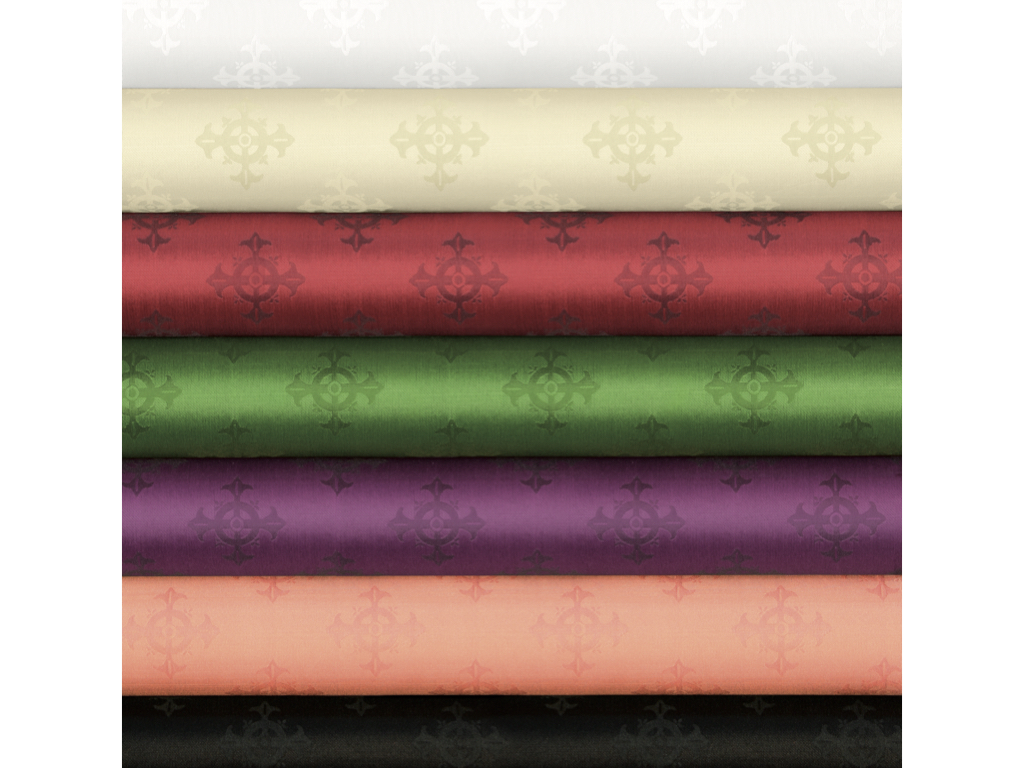Adornes
Damask fabric is named for Damascus, which is where this textile product originated. Known for its intricate and reversible patterns, damask fabric is prized for its ornateness. These days, however, it’s easy to make incredibly complex damask patterns with modern textile machines. Traditionally, damask fabric was made from silk, cotton, or wool, but synthetic damask weaves are now available also.
Is there a difference between Damask and brocade? Damask and brocade are woven differently even though they are used for some of the same purposes. Brocade consists of multiple thread colors all woven together into a pattern, and damask usually consists of a single thread color. There are also differences in the weaving process itself; the brocade weave is “looser,” which often results in loose threads that fray easily. Damask is more durable even though it is generally only available in a single color of yarn (with multiple tones and textures).
Adornes is a man-made fibre. The advantages of man-made fibre are :
- Natural fibers are softer and more natural than their synthetic fiber counterparts but aren’t always as durable.
- Man made or regenerated fibers are often easier to care for than natural fibers without the need for special treatments such as dry cleaning.
- Synthetic fibers can be easily washed in hot water which you wouldn’t recommend with some animal or plant based fabrics. They can also offer better performance in terms of heat, making them great for areas of high humidity and wet climates.
Man-made fibers, such as polyester, offer a interesting alternative to natural fibers. Through the process of polymerization, these fibers are created by combining raw materials to form a versatile polymer. The resulting fibers provide a reliable and sustainable option for various applications and are a great choice for those seeking functional and practical textile solutions.
Washing instructions :
Polyester can be safely dry-cleaned or machine-washed.
Can be machine washed at 30°C maximum. Wash in warm suds, rinse well. Do not wring, hang wet to dry. No ironing needed. Turn polyester-knit garments inside out before washing to prevent snags.
- Machine-wash polyester in warm water, using an all-purpose detergent. Use a chlorine bleach if necessary. Fabric softener will reduce static electricity.
- White polyester fabric will look even whiter if you soak it overnight in a mixture of 1/2 cup automatic dishwashing detergent and 1 gallon warm water. Launder as usual, but add 1/2 cup vinegar to the final rinse.
- Tumble-dry at a low temperature setting. Do not overly dry polyester; this will cause gradual shrinkage.
- Press polyester fabrics at a moderate temperature setting, or use steam.
Keeping vestments clean and dry in storage is the most effective protection. In addition to this make sure that they are 100 percent dirt free before packing. Not only cloths but closets, trunks clean, and dresser drawers should also be clean. Please use a matching garment cover for protection.
Techniques
We offer several techniques that can be used to decorate the paraments. A technique also requires a specific washing instructions.
Please keep following in mind for maintance :
- Hand embroidery : hand wash only with lukewarm water, no bleach. Only very mild detergent. Parament can not be machine washed or taken to dry cleaner. Before washing any vintage or antique pieces, check the fiber content and test the fibers to see if they can withstand washing. Some fibers can't be washed in soap and water, and older pieces might not be sturdy enough. To test a piece, crinkle it gently in your hands while holding it up to your ear. On older pieces, you might hear a gentle crinkling noise as you handle the fabric, which indicates that fibers are breaking. Do not wash a piece that crinkles because this will cause further damage and the piece could disintegrate in the wash.
Newly completed embroidered projects in good condition that have been worked in cotton embroidery thread often need just minimal cleaning, or just need to be vacuumed using a clean piece of nylon cover placed over the vacuum hose (worn-out pantyhose and knee-high stockings are perfect for this). Heavily soiled items might need a mild bath. Hand embroidery that need a thorough cleaning can be freshened easily in room-temperature water with a mild soap like Orvus paste or sodium borate (aka borax) dissolved in water with a ratio of 1 teaspoon per gallon. Allow the piece to soak for 15 to 20 minutes to loosen and release dirt and accumulated debris. Rinse thoroughly after soaking at least twice with clean, room-temperature water.
- Machine embroidery : is machine washable or can be taken to a dry cleaner. However, the maintenance instructions of the fabric needs to be followed first. A machine embroidery on a vestment in Adornes f.ex. does require the washing instructions for Adornes.
- Application technique : give to a reliable dry cleaner only, can not be machine washed. Please always clearly ask that the parament is correctly cleaned according to the composition of the fabric.
- Digital printing : is machine washable or can be taken to a dry cleaner. However, the maintenance instructions of the fabric needs to be followed first. A digital printed symbol on a vestment in Adornes f.ex. does require the washing instructions for Adornes.

